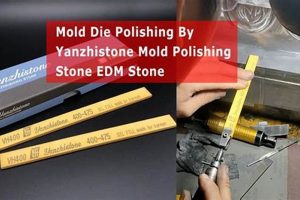This cement-based compound is designed to create an exceptionally smooth and level surface on floors and other substrates. Applied thinly, it fills in minor imperfections such as scratches, gouges, or uneven textures. For example, it can be used to prepare concrete floors for the installation of vinyl, tile, or other floor coverings, ensuring a professional and aesthetically pleasing result.
The application of this type of product offers several advantages. Primarily, it provides a consistent base, mitigating the risk of telegraphing imperfections through the final floor finish. This not only improves the appearance but can also extend the lifespan of the finished floor by preventing undue stress points. The development of such materials represents an advancement in surface preparation techniques, allowing for more efficient and reliable results in construction and renovation projects.
Understanding the properties and application techniques of this smoothing compound is crucial for achieving optimal results. The following sections will delve into specific product characteristics, preparation methods, and best practices for its effective use, enabling successful surface finishing outcomes.
Application Tips for Optimal Results
The successful use of this smoothing compound relies on adherence to best practices during preparation and application. Consistent results are achievable by focusing on the following crucial steps.
Tip 1: Substrate Preparation is Paramount: Thoroughly clean the surface to remove dust, debris, grease, and any loose material. A clean surface ensures proper adhesion and prevents the compound from delaminating or cracking. Consider mechanical abrasion for optimal bonding to existing concrete.
Tip 2: Prime for Enhanced Adhesion: Use a compatible primer before application. Priming promotes a strong bond between the substrate and the compound, preventing premature failure. Follow the manufacturer’s recommendations regarding primer selection and application rates.
Tip 3: Precise Mixing is Essential: Adhere strictly to the water-to-powder ratio specified by the manufacturer. Deviations can compromise the compound’s strength, workability, and setting time. Employ a mechanical mixer for consistent blending and to eliminate lumps.
Tip 4: Apply Thin, Even Coats: The compound is designed for thin applications. Avoid applying excessive amounts in a single pass, as this can lead to cracking and prolonged drying times. Multiple thin layers are preferable to a single thick layer.
Tip 5: Use the Correct Tools: Employ a flexible steel trowel for smooth and even spreading. Select the appropriate trowel size based on the area being covered and the desired finish. Maintain a consistent angle and pressure throughout the application process.
Tip 6: Allow Adequate Drying Time: Observe the recommended drying time before applying subsequent layers or floor coverings. Premature covering can trap moisture and compromise the integrity of the finished surface. Ensure adequate ventilation to facilitate drying.
Tip 7: Sand Lightly for Perfection: Once fully cured, lightly sand the surface to remove any minor imperfections or ridges. This step further enhances the smoothness and prepares the surface for the final floor finish. Use fine-grit sandpaper to avoid scratching.
By following these tips, users can maximize the performance and longevity of this surface smoothing solution, achieving a flawlessly prepared substrate for various flooring applications.
The subsequent sections of this document will explore potential challenges and troubleshooting techniques associated with this material.
1. Thin layer application
The capacity for thin layer application is a fundamental characteristic that defines the utility of this cement-based compound. Its design facilitates the application of exceptionally thin coatings, typically ranging from skim coats to feather edges. This attribute is not merely a convenient feature; it is integral to the product’s function and intended purpose. The thin application allows for precise leveling of minor surface irregularities, scratches, or imperfections without significantly altering the overall elevation of the substrate. For instance, a concrete floor with hairline cracks or slight undulations can be rendered perfectly smooth and level with a thin application, providing an ideal surface for the subsequent installation of delicate materials like vinyl or engineered wood. Without this capacity for thin-layer application, the compound would be unsuitable for its primary application, as thicker coatings could introduce new unevenness or require extensive grinding and leveling.
The importance of the thin layer application capability extends beyond simple surface smoothing. It directly influences the adhesion, drying time, and overall performance of the smoothing compound. Thicker applications are prone to cracking during the drying process due to uneven moisture release, weakening the bond to the substrate and potentially causing delamination. Thin layers, in contrast, dry more uniformly and quickly, minimizing the risk of cracking and promoting a stronger, more durable bond. Furthermore, thin applications allow for greater control over the final surface profile, enabling precise adjustments to achieve the desired levelness. Consider the renovation of an older building where floor heights must match adjacent rooms; the thin application capability becomes invaluable for precisely correcting minor differences without requiring extensive and costly reconstruction.
In summary, the ability to apply thin layers is not merely a property but a defining characteristic that makes the compound suitable for creating smooth, level surfaces. It directly influences adhesion, drying time, and the final surface profile, and it is crucial for achieving optimal results in a wide range of flooring applications. Challenges such as choosing the correct product for the degree of unevenness, or ensuring a perfectly clean substrate for proper bonding must be carefully addressed in every project. Ultimately, the effectiveness of the surface smoothing compound hinges on the proper understanding and execution of its thin layer application capabilities.
2. Surface imperfection repair
Surface imperfection repair is a core application for cement-based smoothing compounds like this particular feather finish product. The inherent function of this type of material lies in its ability to address and rectify minor flaws on various substrates, preparing surfaces for subsequent finishing or covering.
- Filling Voids and Cracks
One primary role of this product is to fill small voids, hairline cracks, and pinholes commonly found in concrete and other surfaces. These imperfections, if left untreated, can compromise the integrity of the final finish, causing telegraphing (where the imperfection is visible through the overlaying material) or premature wear. The fine particle size of the feather finish allows it to penetrate and fill these minute defects, creating a uniform and stable base. For example, consider a concrete floor with shrinkage cracks; application can effectively bridge and conceal these cracks, preventing them from propagating through a new layer of tile.
- Smoothing Rough Textures
Uneven or coarse surfaces can hinder the adhesion of flooring materials or paint. The material provides a mechanism to smooth and level such textures, eliminating protrusions and depressions that would otherwise interfere with the application of subsequent layers. Imagine applying a thin coat of epoxy over a concrete surface with aggregate exposure. Application would create a perfectly smooth canvas, ensuring even distribution and optimal bonding of the epoxy coating.
- Repairing Spalls and Chips
Superficial damage, such as spalls (small fragments broken off the surface) and chips, are common in concrete and other materials. These localized defects can be unsightly and structurally unsound. A thin layer of this product can be used to repair these areas, restoring the original surface profile and preventing further deterioration. As an example, consider a concrete countertop with a chipped edge; the smoothing compound can be applied to fill the void and create a seamless repair, restoring both the appearance and functionality of the countertop.
- Feathering Edges and Transitions
The “feather” in “feather finish” refers to its ability to create exceptionally thin edges that blend seamlessly with the surrounding surface. This is particularly useful for repairing transitions between different materials or for smoothing out repairs that require a gradual transition in thickness. For instance, where a concrete floor meets a tile floor, this compound can be used to create a smooth, level transition, eliminating tripping hazards and enhancing the aesthetic appeal of the space.
In all these scenarios, the success of surface imperfection repair hinges on proper preparation, application technique, and adherence to manufacturer’s instructions. Effectively addressing these flaws with a product like the feather finish compound contributes to a more durable, aesthetically pleasing, and long-lasting final result.
3. Cement-based composition
The cement-based composition forms the foundational element of the smoothing compound. This composition dictates numerous characteristics of the final product, including its adhesion properties, compressive strength, and overall durability. The selection of specific cement types and additives directly influences the compound’s suitability for various applications. For example, the use of Portland cement, often modified with polymers, contributes to the compound’s ability to bond effectively to concrete substrates. Without this inherent compatibility, the smoothing compound would be prone to delamination and failure. The careful formulation of the cement matrix ensures that the compound can withstand the stresses associated with typical flooring applications.
The specific cementitious materials used within the compound’s formulation also impact its workability and setting time. Certain additives can accelerate or retard the hydration process, allowing for greater control during application. This is particularly important when working on large areas or in environments with varying temperatures. The cement’s fine particle size is crucial for achieving a smooth, feather-edged finish. Coarser particles would compromise the ability to create a seamless transition between the compound and the existing substrate. Real-world examples of its efficacy include leveling uneven concrete floors prior to tile installation or smoothing patched areas on walls before painting. The composition directly enables the creation of a flawlessly uniform surface.
In summary, the cement-based composition is not merely an ingredient but rather the defining factor in the performance and applicability of smoothing compounds. Its precise formulation ensures adhesion, durability, workability, and the ability to achieve a feather-edged finish. While challenges may arise concerning the selection of the appropriate compound for specific substrates or environmental conditions, the fundamental understanding of the cement matrix remains paramount for successful application and long-lasting results. It directly relates to the effectiveness as a surface preparation and repair material, linking back to the overarching importance of proper substrate preparation in construction and renovation projects.
4. Smooth, level substrate
The attainment of a smooth, level substrate represents the primary objective when employing a feather finish compound. The relationship between the material and this outcome is one of direct cause and effect. The compound, through its inherent properties and correct application, facilitates the creation of a planar surface, free from imperfections and irregularities. The importance of a smooth, level substrate cannot be overstated; it serves as the essential foundation for subsequent flooring installations, ensuring proper adhesion, uniform load distribution, and aesthetic appeal. An example illustrating this principle is the preparation of a concrete floor prior to the installation of thin-set tile. If the concrete surface is uneven, the tile installation will be compromised, potentially leading to cracking, lippage (uneven tile edges), and ultimately, premature failure of the tiled surface. The feather finish compound acts as the remedial agent, filling voids, smoothing rough textures, and creating a level plane to ensure a successful tile installation. Understanding this relationship is practically significant for contractors, installers, and anyone involved in flooring projects, as it directly impacts the quality and longevity of the finished product.
Further analysis reveals that the feather finish compound is specifically formulated to address the common challenges encountered in achieving a smooth, level substrate. Its fine particle size allows it to penetrate and fill even the smallest imperfections, while its self-leveling properties promote a uniform distribution across the surface. The rapid-setting nature of some feather finish compounds further expedites the preparation process, minimizing downtime and maximizing efficiency. Practical applications extend beyond flooring; it can be used to smooth walls prior to painting, repair damaged countertops, and create seamless transitions between different flooring materials. Consider a scenario where an existing vinyl floor has been removed, leaving behind adhesive residue and minor imperfections. The application of a feather finish compound provides a clean, smooth surface, ready to receive a new flooring material or coating.
In conclusion, the direct correlation between a feather finish compound and a smooth, level substrate underscores its vital role in surface preparation. The compound acts as the means to achieve the end, ensuring a stable, uniform, and aesthetically pleasing foundation for a variety of flooring and finishing applications. While challenges may arise in selecting the appropriate compound for specific substrates or environmental conditions, the fundamental principle remains the same: the meticulous preparation of the substrate with a feather finish is essential for achieving optimal results and preventing costly failures. This highlights the broader theme of prioritizing preparation and attention to detail in all phases of construction and renovation projects.
5. Floor preparation solution
The phrase “floor preparation solution” broadly encompasses a range of materials and techniques designed to render a subfloor suitable for the installation of a final floor covering. Within this spectrum, a feather finish compound represents a specific type of solution, characterized by its cementitious composition and capability for ultra-thin application. The cause-and-effect relationship is evident: the problem is an imperfect subfloor, and the effect is a smooth, level surface achieved through the correct use of the feather finish. Its importance lies in its capacity to address minor imperfections that, if left uncorrected, would compromise the integrity and aesthetics of the finished floor. Consider a scenario involving the installation of luxury vinyl tile (LVT) over a concrete subfloor exhibiting minor cracks and surface irregularities. Direct installation would result in the telegraphing of these imperfections through the LVT, leading to an uneven appearance and potential premature wear. In this case, the use of a feather finish, as a floor preparation solution, mitigates these risks, providing a uniform and stable foundation for the LVT.
Further analysis reveals that the utility extends beyond simply concealing imperfections. The product also enhances the bond between the subfloor and the final flooring material. The cementitious nature of the compound ensures compatibility with concrete substrates, while its smooth surface promotes optimal adhesion. As a practical application, consider the renovation of a commercial space where existing tile is being replaced with a new epoxy coating. The existing tile adhesive residue and minor surface damage necessitate thorough preparation. A feather finish compound can be applied to create a seamless surface, ensuring uniform epoxy coverage and a durable, long-lasting finish. Moreover, its quick-setting properties minimize downtime, making it a particularly efficient solution in time-sensitive projects.
In summary, the use of feather finish aligns directly with the broader concept of a “floor preparation solution.” Its cementitious nature, thin application capability, and ability to create a smooth, level surface enable effective resolution of subfloor imperfections. The benefits extend to improved aesthetics, enhanced durability, and optimized adhesion of the final floor covering. While selecting the appropriate floor preparation solution requires careful consideration of the specific substrate and flooring material, the proper application of a feather finish serves as a critical step in achieving a successful and lasting flooring installation. This reinforces the importance of meticulous surface preparation in all construction and renovation endeavors.
6. Enhanced flooring lifespan
The longevity of a flooring installation is intrinsically linked to the quality of the subfloor preparation. The application of a smoothing compound directly contributes to this extended lifespan by mitigating potential failure points and optimizing conditions for the flooring material.
- Mitigation of Stress Points
Uneven subfloors create localized stress concentrations under the floor covering. These stress points can lead to cracking, delamination, and premature wear, particularly in rigid materials like tile or stone. The application of the compound evens out the substrate, distributing loads uniformly and minimizing stress. For instance, on a concrete slab with minor undulations, proper leveling with the compound prevents point loading on tiles, thus reducing the risk of cracking under heavy foot traffic.
- Prevention of Telegraphing
Subfloor imperfections can “telegraph” through the floor covering, resulting in an aesthetically displeasing appearance and potentially accelerating wear. Thin or flexible floor coverings, such as vinyl or laminate, are particularly susceptible to this phenomenon. The smoothing action of the compound eliminates minor bumps, cracks, and variations in texture, preventing these imperfections from being visible in the finished floor. A properly smoothed subfloor ensures that the floor covering lies flat and evenly, maintaining its intended appearance and structural integrity.
- Improved Adhesion
A smooth, level surface provides an ideal bonding surface for adhesives. Proper adhesion is critical for preventing movement, cupping, and other forms of floor covering failure. By eliminating dust, debris, and surface irregularities, the compound creates a clean, receptive surface that maximizes the bond strength between the subfloor and the flooring material. For instance, when installing hardwood flooring, a properly prepared subfloor ensures that the adhesive can effectively grip the wood, preventing squeaking and movement over time.
- Moisture Management
While not a primary function, some formulations can contribute to moisture management. By filling minor cracks and pores in the subfloor, the compound can reduce the migration of moisture vapor from the substrate into the floor covering. Excessive moisture can lead to warping, mold growth, and adhesive failure. For instance, in basements or other moisture-prone environments, a properly applied compound can serve as a supplementary barrier, helping to protect the floor covering from moisture damage and extending its lifespan.
The long-term benefits of using a smoothing compound during floor preparation are significant. By addressing potential failure points and optimizing conditions for the floor covering, it contributes directly to a more durable, aesthetically pleasing, and cost-effective flooring installation. Therefore, proper subfloor preparation with such a compound is not merely an optional step but a critical investment in the longevity of the finished floor.
Frequently Asked Questions About Ardex Feather Finish
This section addresses common inquiries regarding the application, properties, and optimal usage of Ardex Feather Finish, providing concise and informative answers to assist users in achieving successful results.
Question 1: What is the primary purpose of Ardex Feather Finish?
It serves as a cement-based skim coat, designed to smooth and level interior surfaces prior to the installation of flooring materials. It is particularly useful for filling minor imperfections, such as scratches, gouges, and uneven textures, on concrete, wood, and other substrates.
Question 2: What is the maximum thickness Ardex Feather Finish can be applied at?
This product is designed for thin applications. It is typically applied in layers no thicker than 1/8 inch (3 mm). Exceeding this thickness can lead to cracking and compromised adhesion.
Question 3: Is priming required before applying Ardex Feather Finish?
Priming is generally recommended to enhance adhesion, particularly on porous or dusty substrates. The appropriate primer will depend on the specific substrate material and should be selected according to the manufacturer’s recommendations. Consult the product data sheet for guidance on primer compatibility.
Question 4: What is the recommended mixing ratio for Ardex Feather Finish?
The recommended mixing ratio is typically specified on the product packaging. Precise adherence to this ratio is crucial for achieving the desired consistency and performance. Overwatering can weaken the compound, while insufficient water can result in poor workability.
Question 5: What is the approximate drying time for Ardex Feather Finish?
Drying time varies depending on environmental conditions, such as temperature and humidity, as well as the thickness of the application. Under typical conditions, it generally dries sufficiently for light foot traffic within 15-30 minutes. However, allowing a longer drying period before installing flooring is advisable to ensure complete curing.
Question 6: Can Ardex Feather Finish be used on exterior surfaces?
Ardex Feather Finish is primarily designed for interior use. Exterior applications are generally not recommended due to its limited resistance to weathering and moisture exposure. Products specifically formulated for exterior use should be considered for outdoor applications.
These FAQs offer a concise overview of key considerations for utilizing Ardex Feather Finish effectively. Refer to the manufacturer’s product data sheet for comprehensive instructions and safety precautions.
The subsequent section will delve into the common challenges encountered during the application and suggest troubleshooting techniques.
Conclusion
The preceding exploration has detailed the properties, applications, and significance of ardit feather finish within the broader context of surface preparation and flooring installation. The information presented has underscored its role in creating smooth, level substrates, mitigating stress points, and ultimately contributing to enhanced flooring lifespan. Adherence to best practices in substrate preparation, mixing, and application is paramount for achieving optimal results.
Effective utilization of ardit feather finish requires a thorough understanding of its characteristics and limitations. While it offers a valuable solution for addressing minor imperfections, it is not a substitute for proper subfloor construction or major repairs. Informed application and careful consideration of environmental factors are critical for realizing its full potential and ensuring lasting performance in flooring installations.







